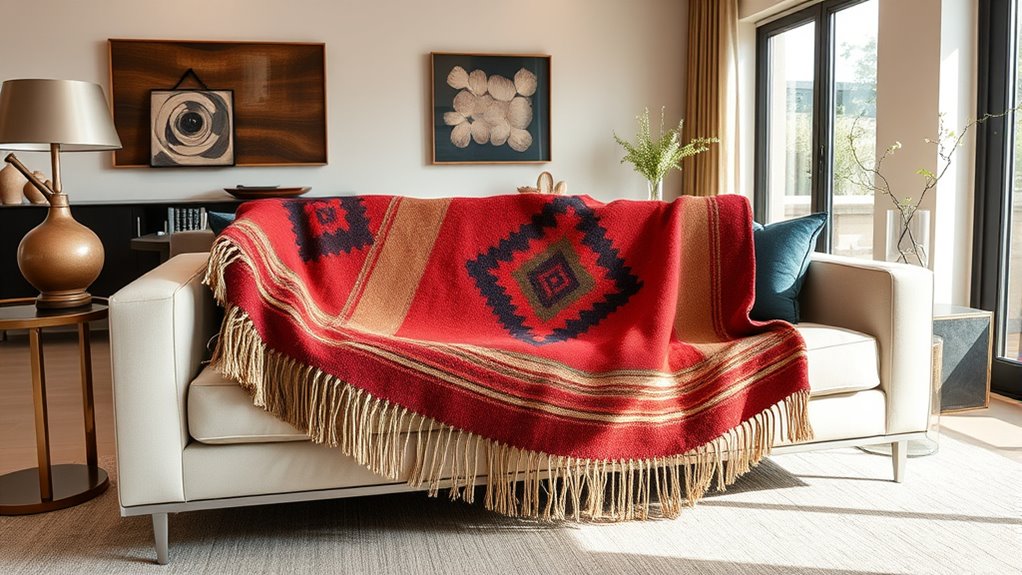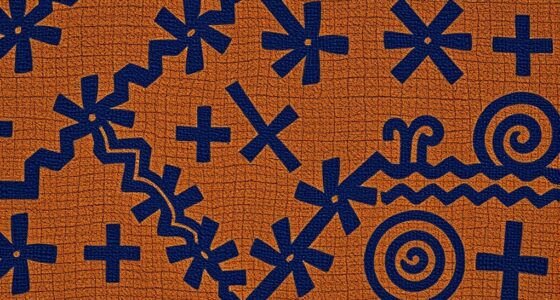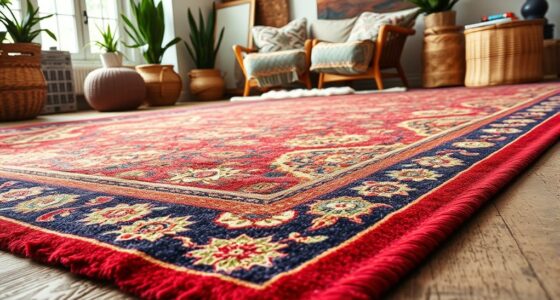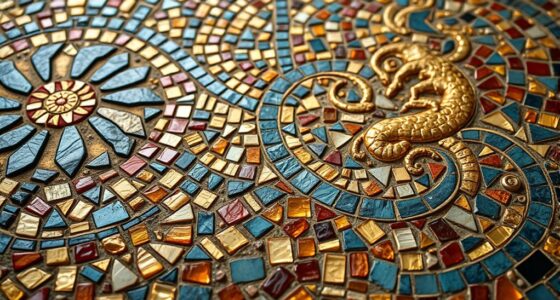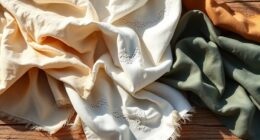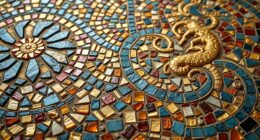Indigenous weaving deeply influences modern decor by blending traditional symbols, patterns, and natural materials into contemporary design. You’ll often see authentic textiles used as statement pieces or functional accents that add cultural depth and texture. Many artisans now combine age-old techniques with modern aesthetics, ensuring these crafts stay relevant. Embracing indigenous weaving enriches your space with storytelling and sustainability—exploring further reveals inspiring ways to incorporate these timeless arts into your home.
Key Takeaways
- Indigenous weaving introduces authentic textures and patterns, adding cultural depth to modern interior designs.
- Traditional techniques are integrated with contemporary aesthetics, creating unique statement pieces.
- Patterns and symbolism from indigenous textiles enhance storytelling and cultural significance in decor.
- Incorporating indigenous textiles promotes sustainability and supports local artisans in modern spaces.
- Modern designers blend age-old craftsmanship with minimalism, fostering cultural preservation within current trends.
Historical Roots and Cultural Significance of Indigenous Weaving
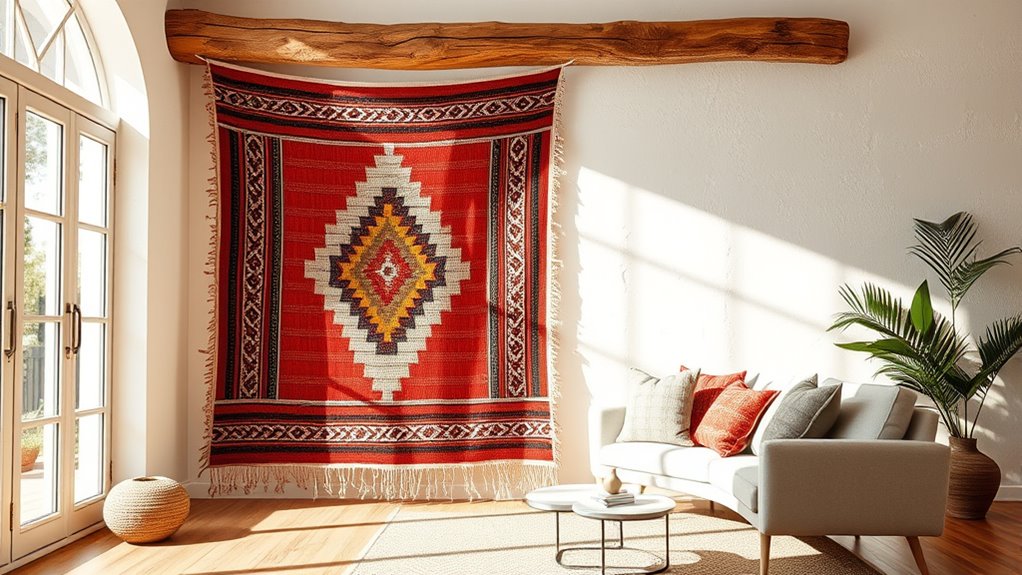
Indigenous weaving has deep roots that stretch back centuries, serving as an essential expression of cultural identity and tradition. Many believe these practices originate from mythical origins, where weaving stories intertwine with legends and spiritual beliefs. The craft often holds ritual significance, used in ceremonies to honor deities, mark life milestones, or seek protection. These textiles embody more than artistry—they’re sacred symbols that preserve history and beliefs across generations. You can see how weaving connects community members through shared stories and spiritual practices. This layered significance elevates indigenous textiles beyond mere decoration, making them powerful cultural artifacts. Understanding these roots helps you appreciate their value, not just as beautiful objects but as living traditions that continue to shape identity and spiritual life today. Additionally, the intricate patterns and techniques are often influenced by cultural heritage, reflecting the unique history and beliefs of each community.
Traditional Techniques and Materials in Indigenous Textiles
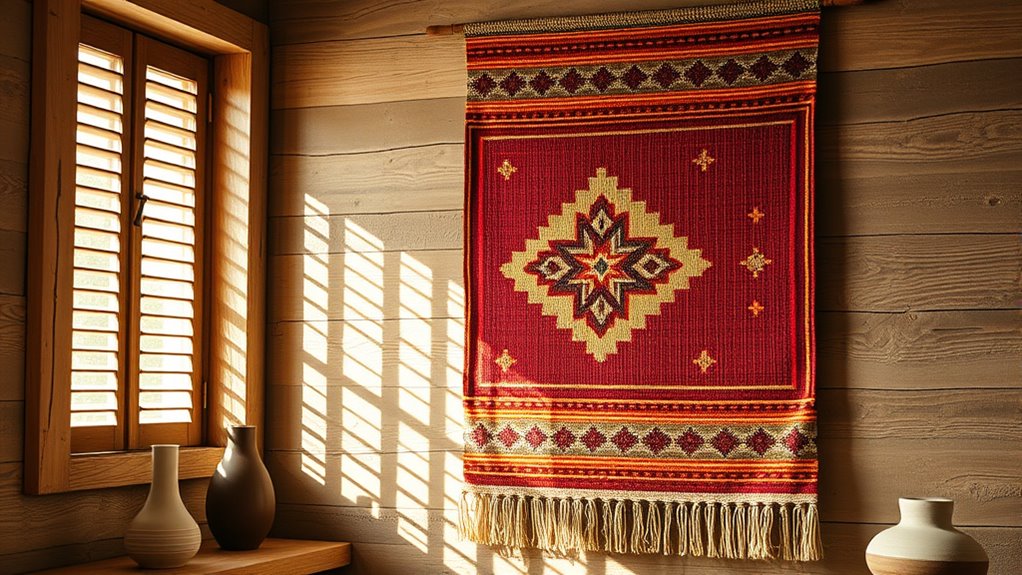
Traditional Techniques and Materials in Indigenous Textiles include the use of natural fibers, dyes, and weaving methods passed down through generations. These techniques often involve intricate patterns and symbolism unique to each Indigenous community. Modern decor has begun to incorporate these textiles to add cultural depth and authenticity to interior spaces. Additionally, some artisans are integrating contemporary designs with traditional methods to appeal to a broader audience. The preservation of these techniques is vital for maintaining cultural heritage and supporting local artisans. Recognizing the authenticity of materials used in Indigenous weaving enhances appreciation for their craftsmanship and cultural significance.
Iconic Patterns and Symbolism in Indigenous Designs

Many indigenous weavers incorporate iconic patterns and symbolism into their designs to tell stories, convey cultural values, and honor ancestral traditions. These symbolic motifs serve as visual language, connecting you to a rich cultural heritage. You’ll notice that:
Indigenous weavers use symbols and patterns to tell stories and honor cultural traditions through visual storytelling.
- Patterns often represent natural elements like animals, plants, or celestial bodies.
- Geometric shapes symbolize spiritual beliefs or societal structures.
- Repeated motifs reinforce community identity and shared history.
- Colors carry specific meanings, reflecting emotions or environmental significance.
- The forSale 100 of these traditional designs has also influenced contemporary home decor, blending cultural symbolism with modern aesthetics.
The Transition From Traditional Craft to Modern Decor
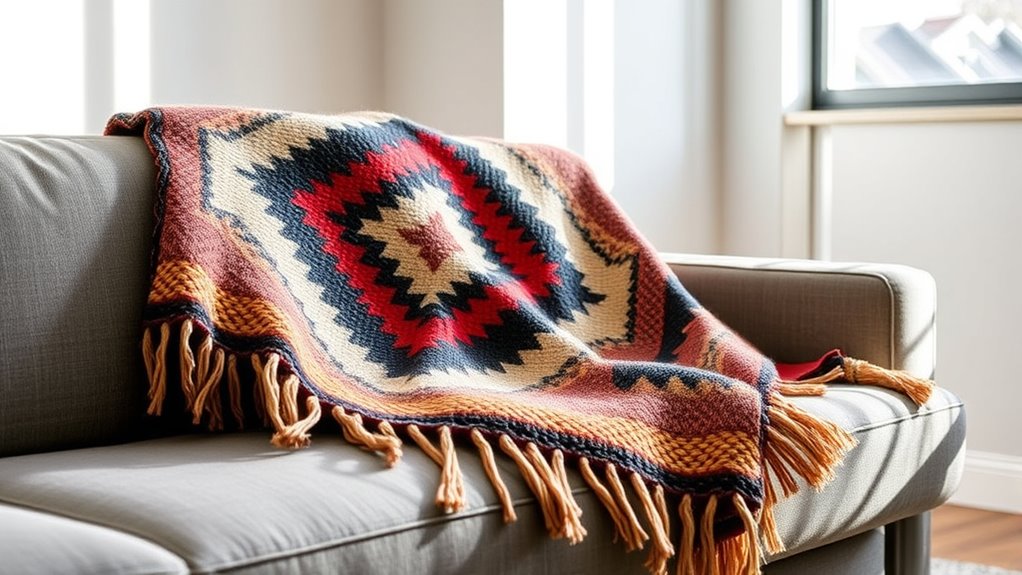
As contemporary interior design evolves, traditional indigenous weaving techniques are increasingly finding their place in modern decor. You’ll notice how these textiles blend seamlessly with modern minimalist aesthetics, adding texture and cultural depth without clutter. This shift reflects a shift towards urban sustainability, where artisans adapt age-old methods for contemporary spaces. Incorporating woven pieces as statement accents or functional decor emphasizes simplicity and craftsmanship. The integration of indigenous textiles also promotes cultural storytelling, connecting modern spaces with rich heritage. Here’s a quick overview:
| Aspect | Traditional Craft | Modern Decor |
|---|---|---|
| Design Approach | Symbolic patterns, vibrant colors | Minimalist, subdued palettes |
| Usage | Wall hangings, upholstery | Wall art, cushions, throws |
| Material | Natural fibers, dyes | Eco-friendly, sustainable options |
| Cultural Significance | Community identity | Contemporary storytelling |
| Integration | Preservation, adaptation | Trendsetting in urban homes |
This shift makes indigenous weaving a crucial part of modern decor with sustainability at its core.
Sustainable Practices and Eco-Friendly Aspects of Indigenous Weaving
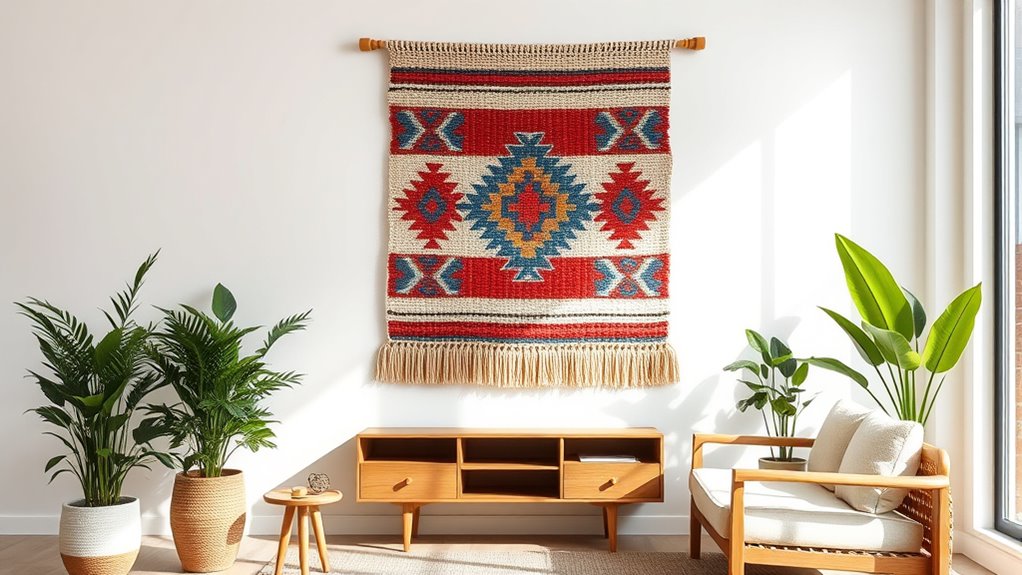
Indigenous weaving practices inherently promote sustainability by utilizing natural fibers and dyes that are biodegradable and locally sourced. This approach ensures minimal environmental impact and supports local economies. By adopting sustainable practices, you benefit from eco-friendly aspects such as reduced chemical use and waste. Additionally, traditional weaving techniques often foster a slow craftsmanship approach, emphasizing quality and durability over mass production.
Influences on Contemporary Interior Design and Home Accessories

Contemporary interior design increasingly incorporates indigenous weaving techniques and motifs to add authenticity, texture, and cultural depth to spaces. You’ll notice these influences in home accessories like rugs, throws, and wall hangings, enriching your environment with meaningful craftsmanship. Modern designers draw inspiration from contemporary fashion, integrating vibrant patterns and textiles that reflect indigenous aesthetics. Urban architecture also benefits from these weaving traditions, often featuring woven elements in facades or interior partitions that soften sleek, concrete structures. This blend of old and new creates a dynamic visual language, connecting your living space to broader cultural narratives. Incorporating traditional weaving patterns into modern decor not only elevates aesthetic appeal but also preserves and celebrates indigenous heritage. By embracing indigenous weaving, your decor becomes more than just stylish—it becomes a statement of heritage, innovation, and respect for traditional artistry in a modern context.
Collaborations Between Indigenous Artisans and Modern Designers
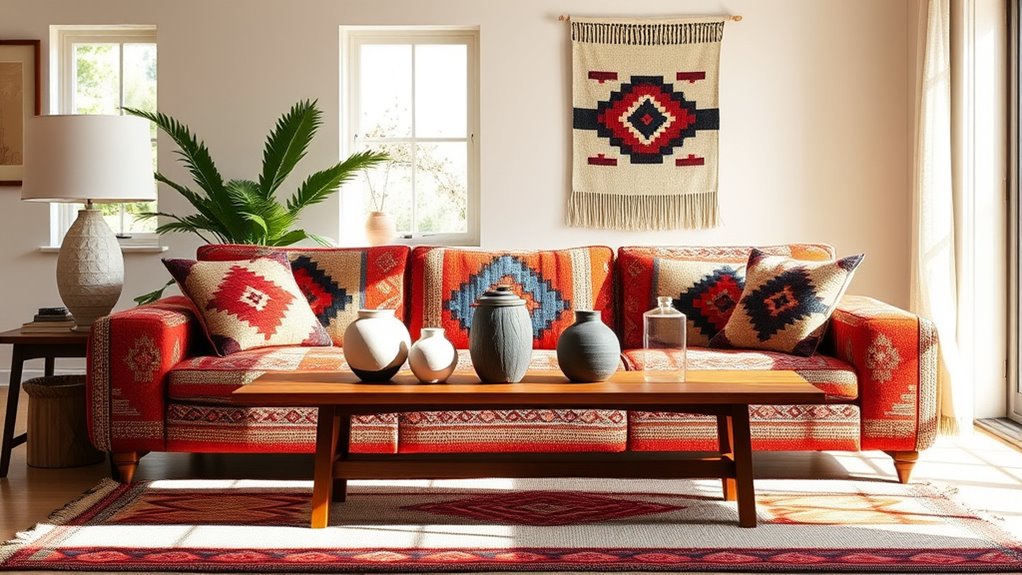
Collaborations between indigenous artisans and modern designers create unique opportunities to preserve cultural heritage while innovating with new ideas. These partnerships blend traditional techniques with contemporary aesthetics, resulting in fresh, meaningful designs. By working together, they guarantee that indigenous craftsmanship continues to thrive in today’s decor landscape. Incorporating cultural heritage preservation into design collaborations ensures that traditional art forms are respected and celebrated.
Preserving Cultural Heritage
When modern designers partner with indigenous artisans, they help guarantee that traditional weaving techniques and cultural stories are kept alive. This collaboration safeguards cultural symbolism and craftsmanship techniques essential to indigenous identity. You play a key role in this preservation by: 1. Supporting artisans who pass down unique weaving methods. 2. Promoting designs that highlight cultural symbolism embedded in textiles. 3. Ensuring fair compensation, which sustains traditional practices. 4. Raising awareness about the importance of preserving cultural heritage through modern decor. Additionally, emphasizing the significance of authentic craftsmanship helps maintain the cultural integrity of indigenous textiles.
Innovative Design Synergies
By merging traditional weaving techniques with modern design perspectives, artisans and designers create innovative pieces that resonate across cultures and styles. They experiment with textile dyes, using natural and synthetic colors to achieve vibrant, contemporary effects while honoring traditional palettes. Modern designers often collaborate with indigenous artisans, integrating weaving tools to refine craftsmanship and introduce new textures. These partnerships lead to unique textiles that blend ancient methods with current aesthetics, making them suitable for diverse decor styles. The fusion sparks fresh ideas, pushing the boundaries of indigenous art and enhancing its relevance in contemporary spaces. Additionally, incorporating innovative design techniques can elevate traditional textiles to new artistic heights. As a result, these design synergies foster cultural exchange, support artisan communities, and inspire innovative decor solutions rooted in tradition yet forward-looking.
Challenges and Opportunities for Preserving Indigenous Weaving Traditions
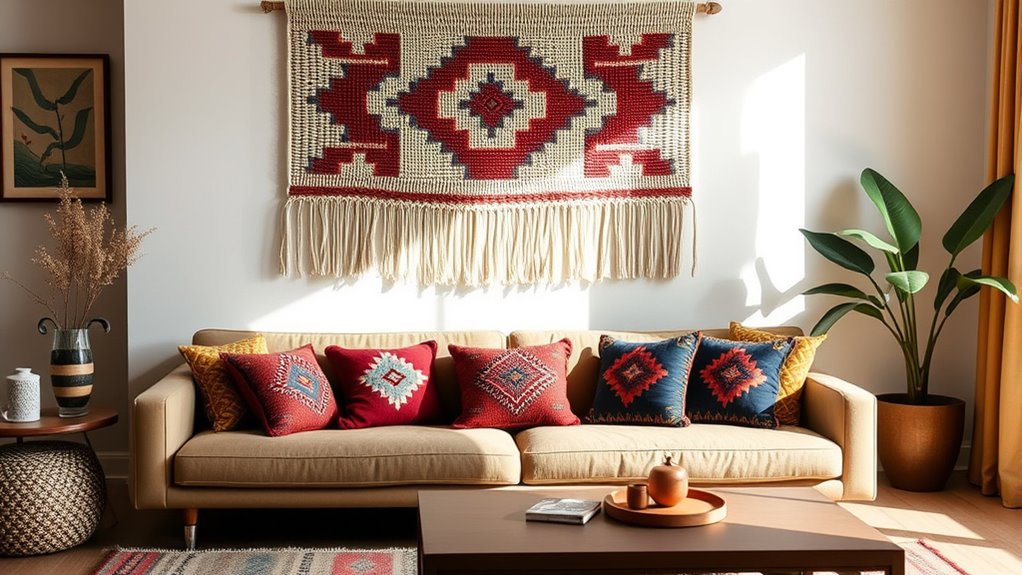
Preserving indigenous weaving traditions faces significant hurdles in a rapidly changing world. Modern marketing often favors mass-produced items, making authentic craftsmanship less visible. Globalization impacts local artisans by introducing cheaper imports, threatening traditional practices. To overcome these challenges, you can focus on:
- Promoting indigenous textiles through targeted marketing campaigns that highlight cultural value.
- Supporting local artisans to sustain traditional techniques in competitive markets.
- Creating partnerships that preserve craftsmanship while expanding global reach.
- Educating consumers on the importance of authentic indigenous weaving and its cultural significance.
- Recognizing the role of cultural heritage in maintaining the uniqueness of indigenous weaving traditions.
These opportunities help keep traditions alive despite external pressures. By embracing modern marketing strategies and understanding globalization impacts, you can play a crucial role in safeguarding these rich cultural heritages for future generations.
How to Incorporate Indigenous Textiles Into Your Personal Space
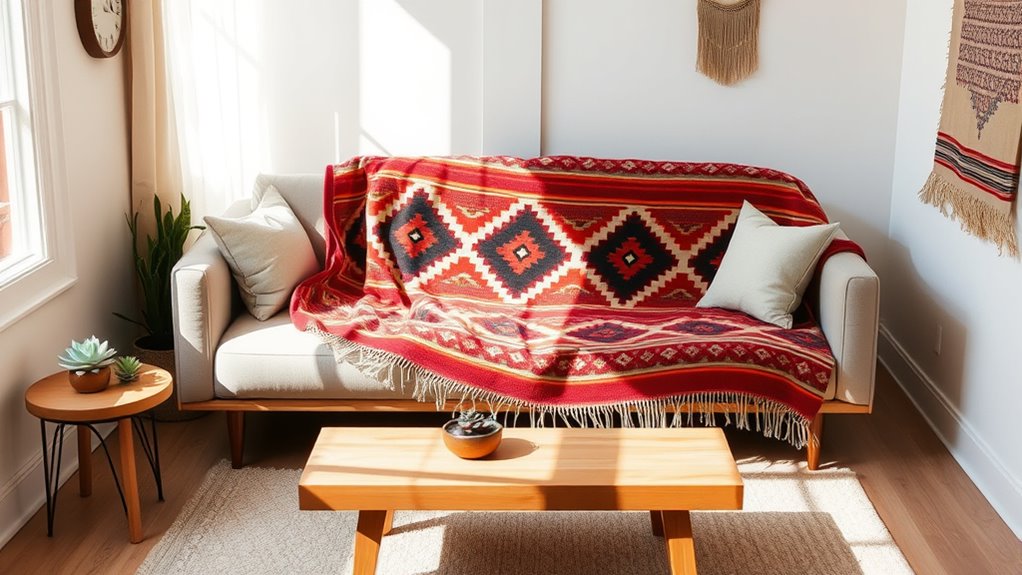
To incorporate indigenous textiles into your space, start by selecting authentic pieces that respect their cultural significance. Pair these textiles with complementary decor styles to create a cohesive look, and remember to care for them properly to preserve their beauty and meaning. With thoughtful choices, you can celebrate indigenous artistry while enhancing your personal environment. Engaging with community engagement can also deepen your appreciation and understanding of the cultural context behind these textiles.
Choosing Authentic Textiles
Choosing authentic indigenous textiles requires a mindful approach to guarantee you honor their cultural significance. First, verify the textile’s origin to ensure it’s genuine and ethically sourced. Second, check the textile’s durability; quality fabrics withstand daily use without fraying or fading. Third, assess color fastness—colors should stay vibrant after washing and exposure to light. Fourth, consider the weaving techniques used, ensuring they reflect traditional craftsmanship. By focusing on these aspects, you preserve the integrity of the textile and its cultural meaning. Additionally, understanding textile preservation techniques can help maintain the piece’s quality over time. Avoid shortcuts that compromise quality, and always opt for textiles that demonstrate resilience through durability and color fastness. This mindful selection enriches your space while respecting the heritage embedded in each piece.
Complementary Decor Styles
Incorporating indigenous textiles into your decor can beautifully enhance your space when you select complementary styles that highlight their unique craftsmanship. Focus on textile techniques that emphasize their artisanal quality, such as weaving patterns or embroidery styles. Pair these textiles with minimalist furniture to let their vibrant colors and intricate designs stand out. Incorporate cultural symbolism thoughtfully—use motifs or patterns that reflect their heritage, adding depth and meaning to your decor. Neutral backgrounds or contemporary furniture create a balanced contrast that highlights the textiles without overwhelming the space. By blending modern design elements with traditional textiles, you create a harmonious environment that celebrates indigenous craftsmanship while maintaining a stylish, cohesive look.
Care and Preservation
Maintaining the beauty of indigenous textiles requires mindful care that respects their craftsmanship and longevity. To preserve these treasures, start by understanding proper cleaning methods, such as gentle vacuuming or spot cleaning with soft cloths. Next, protect textiles from direct sunlight to prevent fading. Third, consider restoration techniques when fabrics show signs of wear—consult community involvement or experts familiar with traditional methods. Fourth, involve local artisans or organizations dedicated to preservation, ensuring your efforts support cultural sustainability. Regularly inspecting textiles helps catch damage early, while proper storage keeps them safe from pests and humidity. Additionally, educating yourself about cultural significance can deepen your appreciation and guide respectful preservation practices. By combining respectful care with community involvement, you ensure these vibrant textiles remain a meaningful part of your space for generations.
Frequently Asked Questions
How Can I Identify Authentic Indigenous Woven Textiles?
To identify authentic indigenous woven textiles, you should look for clear signs of cultural significance, such as traditional patterns and techniques unique to a community. Check the material authenticity by feeling the fabric—genuine pieces often use natural fibers like cotton, wool, or sisal. Be cautious of machine-made imitations, and when possible, buy directly from artisans or reputable sources to guarantee you’re supporting genuine craftsmanship.
Are Indigenous Weaving Patterns Protected by Intellectual Property Laws?
Indigenous weaving patterns are often protected by intellectual property laws, but enforcement varies. You should respect cultural preservation and artisanal craftsmanship by seeking permission before using traditional designs. Some countries have specific protections for indigenous patterns, ensuring artisans retain rights over their work. Always support authentic artisans and avoid cultural appropriation, helping preserve these rich traditions for future generations while honoring their cultural significance.
What Are Common Misconceptions About Indigenous Textiles in Modern Decor?
Have you ever thought that indigenous textiles are just trendy decor? Many believe they lack cultural significance, but that’s a misconception. These textiles carry deep stories and traditions, and preservation efforts aim to honor that history. When you incorporate indigenous weaving into modern decor, you’re not just adding style—you’re respecting and supporting cultural heritage. Recognizing their true value helps prevent cultural appropriation and keeps these rich traditions alive.
How Do Indigenous Weaving Techniques Influence Contemporary Design Trends?
You can see indigenous weaving techniques shaping contemporary design trends through their focus on cultural authenticity and design innovation. When you incorporate these methods, you bring a sense of tradition that enriches modern decor with meaningful patterns and textures. This influence encourages you to blend old and new, creating unique spaces that honor heritage while showcasing creativity. By embracing indigenous weaving, you help keep cultural stories alive in today’s interior design.
Can Indigenous Textiles Be Integrated Into Minimalist Interior Styles?
Like a delicate thread weaving through a simple fabric, indigenous textiles can seamlessly blend into minimalist interiors. You can incorporate their intricate patterns as focal points, adding depth without overwhelming. Embracing sustainable fashion, you support cultural preservation, enriching your space with meaningful artistry. By thoughtfully integrating these textiles, you create a harmonious balance—respecting tradition while maintaining clean, modern lines—making your decor both stylish and culturally conscious.
Conclusion
Incorporating indigenous weaving into your decor not only adds unique beauty but also supports cultural preservation. If you worry about it feeling out of place, remember that when done thoughtfully, these textiles bring warmth and authenticity to any space. By choosing genuine, ethically sourced pieces, you embrace tradition while enhancing your home’s style. So go ahead—celebrate these rich crafts and make your decor truly meaningful, all while respecting their cultural roots.

